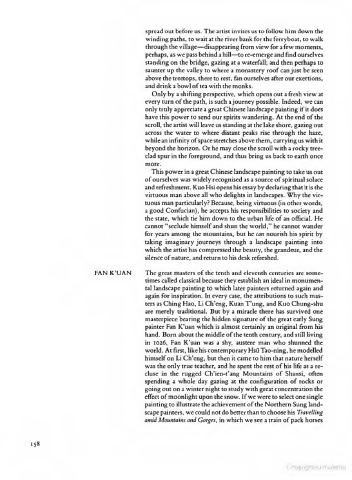Page 178 - The Arts of China, By Michael Sullivan Good Book
P. 178
spread out before us. The artist invites us to follow him down the
winding paths, to wait at the river bank for the ferryboat, to walk
through the village—disappearing from view for a few moments,
perhaps, as we pass behind a hill—to re-emerge and find ourselves
standing on the bridge, gazing at a waterfall; and then perhaps to
saunter up the valley to where a monastery roof can just be seen
above the trcetops, there to rest, fan ourselves after our exertions,
and drink a bowl of tea with the monks.
Only by a shifting perspective, which opens out a fresh view at
every turn of the path, is such a journey possible. Indeed, we can
only truly appreciate a great Chinese landscape painting if it does
have this power to send our spirits wandering. At the end of the
scroll, the artist will leave us standing at the lake shore, gazing out
across the water to where distant peaks rise through the haze,
while an infinity ofspace stretches above them, carrying us with it
beyond the horizon. Or he may close the scroll with a rocky tree-
clad spur in the foreground, and thus bring us back to earth once
more.
This power in a great Chinese landscape painting to take us out
of ourselves was widely recognised as a source of spiritual solace
and refreshment. Kuo Hsi opens his essay by declaring that it is the
virtuous man above all who delights in landscapes. Why the vir-
tuous man particularly? Because, being virtuous (in other words,
a good Confucian), he accepts his responsibilities to society and
the state, which tie him down to the urban life of an official. He
cannot "seclude himself and shun the world," he cannot wander
for years among the mountains, but he can nourish his spirit by
taking imaginary journeys through a landscape painting into
which the artist has compressed the beauty, the grandeur, and the
silence of nature, and return to his desk refreshed.
FAN K'UAN The great masters of the tenth and eleventh centuries arc some-
times called classical because they establish an ideal in monumen-
tal landscape painting to which later painters returned again and
again for inspiration. In every case, the attributions to such mas-
ters as Ching Hao, Li Ch'cng, Kuan T'ung, and Kuo Chung-shu
are merely traditional. But by a miracle there has survived one
masterpiece bearing the hidden signature of the great early Sung
painter Fan K'uan which is almost certainly an original from his
hand. Born about the middle of the tenth century, and still living
in 1026, Fan K'uan was a shy, austere man who shunned the
world. At first, like his contemporary Hsu Tao-ning, he modelled
himself on Li Ch'eng, but then it came to him that nature herself
was the only true teacher, and he spent the rest of his life as a re-
cluse in the rugged Ch'ien-t'ang Mountains of Shansi, often
spending a whole day gazing at the configuration of rocks or
going out on a winter night to study with great concentration the
effect of moonlight upon the snow. Ifwe were to select one single
painting to illustrate the achievement of the Northern Sung land-
scape painters, we could not do better than to choose his Travelling
amid Mountains and Gorges, in which we see a train of pack horses
158
Copyrighted material

